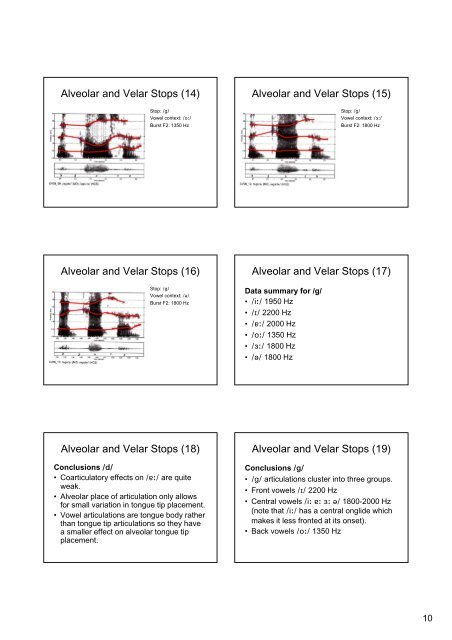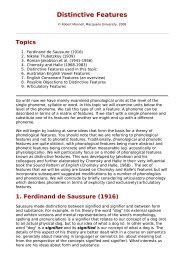PDF version of Lecture Slides - Speech Resource Pages ...
PDF version of Lecture Slides - Speech Resource Pages ...
PDF version of Lecture Slides - Speech Resource Pages ...
Create successful ePaper yourself
Turn your PDF publications into a flip-book with our unique Google optimized e-Paper software.
Alveolar and Velar Stops (14)<br />
Stop: /g/<br />
Vowel context: /o:/<br />
Burst F2: 1350 Hz<br />
Alveolar and Velar Stops (16)<br />
Stop: /g/<br />
Vowel context: /@/<br />
Burst F2: 1800 Hz<br />
Alveolar and Velar Stops (18)<br />
Conclusions /d/<br />
• Coarticulatory effects on /6:/ are quite<br />
weak.<br />
• Alveolar place <strong>of</strong> articulation only allows<br />
for small variation in tongue tip placement.<br />
• Vowel articulations are tongue body rather<br />
than tongue tip articulations so they have<br />
a smaller effect on alveolar tongue tip<br />
placement.<br />
Alveolar and Velar Stops (15)<br />
Stop: /g/<br />
Vowel context: /3:/<br />
Burst F2: 1800 Hz<br />
Alveolar and Velar Stops (17)<br />
Data summary for /g/<br />
• /i:/ 1950 Hz<br />
• /I/ 2200 Hz<br />
• /6:/ 2000 Hz<br />
• /o:/ 1350 Hz<br />
• /3:/ 1800 Hz<br />
• /@/ 1800 Hz<br />
Alveolar and Velar Stops (19)<br />
Conclusions /g/<br />
• /g/ articulations cluster into three groups.<br />
• Front vowels /I/ 2200 Hz<br />
• Central vowels /i: 6: 3: @/ 1800-2000 Hz<br />
(note that /i:/ has a central onglide which<br />
makes it less fronted at its onset).<br />
• Back vowels /o:/ 1350 Hz<br />
10
















